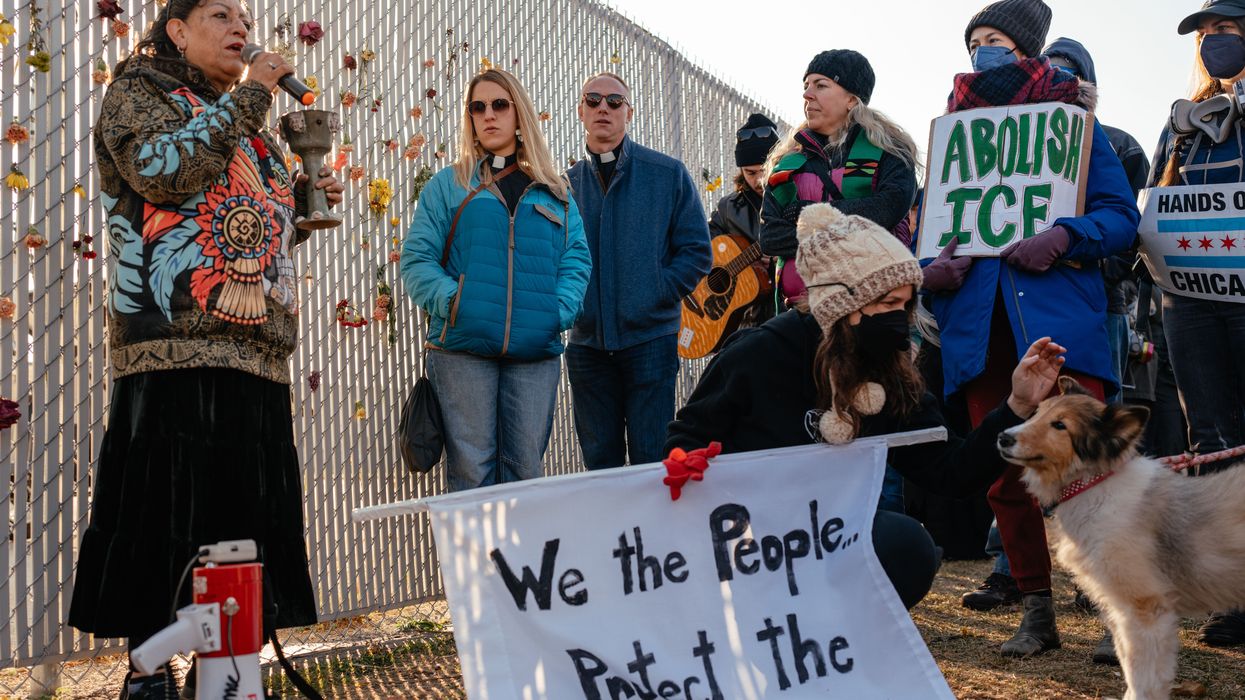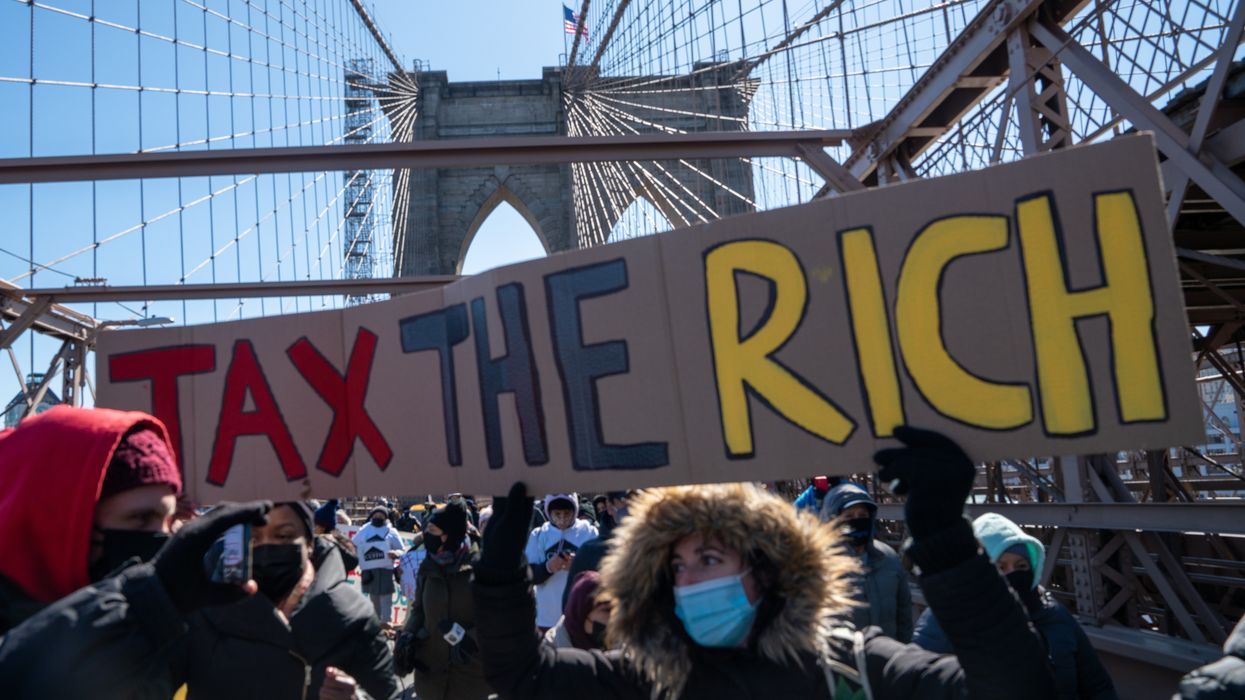November, 20 2019, 11:00pm EDT

Hundreds of Documents Released Detailing Plans to Build Migrant Detention Facilities at Contaminated Fort Bliss Site
Up to 7,500 unaccompanied minors would have been held at toxic site according to plans unearthed by environmental and community advocates.
WASHINGTON
Today, Earthjustice, along with its partners Alianza Nacional de Campesinas, GreenLatinos, Hispanic Federation, Labor Council for Latin American Advancement, National Hispanic Medical Association, and Southwest Environmental Center, is releasing hundreds of internal federal documents on the proposed construction plans for a migrant detention facility at Fort Bliss in Texas. These plans came as a result of President Donald Trump's "zero-tolerance" immigration policy, which instigated a need for additional capacity to house migrants and migrant families detained at the U.S.-Mexico border, which brought on the construction or planning of new detention centers.
These bases are known to be riddled with toxic hazards from past military operations, spills, storage of toxic chemicals, unexploded ordnances, and firing ranges. These searchable records include seven sets of FOIA productions and two key documents pertaining to the plans for construction at Fort Bliss. However, this is not the first time that the administration has pursued construction plans on contaminated sites. Goodfellow AIr Force Base was also under consideration for a planned detention facility.
Though the plans have reportedly stalled, Fort Bliss staff began coordinating with Department of Homeland Security (DHS) and the Department of Health and Human Services (HHS) to select a possible site for a temporary detention camp for families or unaccompanied minors in early May 2018. By the end of June, initial plans were for HHS to house 1,000 unaccompanied minors with possible eventual "incremental build up" to 7,500 unaccompanied minors, to be ready by August 31, 2018, and for DHS to house 2,000 people in a family residential center, with eventual potential buildup to 4,000 beds, according to the newly released documents.
"These documents we're releasing today reveal an alarming effort by the Army and DHS to rush plans to build a family detention center at Fort Bliss without taking the necessary steps to make sure the site was free of toxic hazards. Despite known pollution on the site, the Army planned to build a detention center there without completing a full investigation of the extent of contamination or verifying that the waste had been cleaned up," said Earthjustice attorney Melissa Legge. "This should signal to lawmakers, journalists, and the public how unscrupulous this administration can be while pursuing ill-conceived and dangerous anti-immigration policies."
Our expert's report notes that there were several problems with the project at Fort Bliss, including that the Army did not adequately investigate to determine what types of waste had been disposed of at the site, that the methods used for testing the soil samples were inadequate or never completed, and that samples taken after the supposed clean-up still had concerning levels of pollution. Additionally, our expert notes that illegal dumping on the site may continue to this day. As a result, there is now even greater uncertainty about the environmental hazards at the site and a greater need for thorough testing, analysis, and cleanup.
"The Trump administration has proven again and again that it cannot be trusted with the health and safety of vulnerable migrant children," said Laura M. Esquivel, director of National Advocacy for Hispanic Federation, the lead plaintiffs in the FOIA case. "We have witnessed the tremendous emotional and psychological cost borne by children housed in inhumane conditions. Adding intentional exposure to potentially toxic environments would make the Trump administration responsible for yet another cruel, misguided, and intentional action that would compound the irreparable damage to the physical and mental wellbeing of thousands of migrant children being separated from their parents at the border. The public has the right to know if these conditions exist, and the Trump administration must be held accountable for additional harms caused to those seeking refuge in this country."
The government's actions were probed by health, labor, civil rights, and environmental organizations, represented by Earthjustice, through Freedom of Information Act requests -- as well as record request lawsuits -- to reveal where it planned to detain migrants, then slated to be housed at Fort Bliss Army Base and Goodfellow Air Force Base in Texas, and to identify hazardous waste sites that could impact detention center sites. These documents are a result of that request.
Why does the Freedom of Information Act Matters in our Democracy?
Since 1967, the Freedom of Information Act has provided the public the right to request records from any federal agency. It is the bedrock transparency law that keeps reporters and the American people in the know about their government. The U.S. Supreme Court has found that the "basic purpose of FOIA is to ensure an informed citizenry, vital to the functioning of a democratic society, needed to check against corruption and to hold the governors accountable to the governed."
Earthjustice is a non-profit public interest law firm dedicated to protecting the magnificent places, natural resources, and wildlife of this earth, and to defending the right of all people to a healthy environment. We bring about far-reaching change by enforcing and strengthening environmental laws on behalf of hundreds of organizations, coalitions and communities.
800-584-6460LATEST NEWS
‘It Does Not Have to Be This Way’: Child Hunger Set to Surge as Trump Withholds SNAP Funds
Two federal courts ruled Friday that the White House must release contingency food assistance funds, but officials have suggested they will not comply with the orders.
Oct 31, 2025
Though two federal judges ruled on Friday that the Trump administration must use contingency funds to continue providing food assistance that 42 million Americans rely on, White House officials have signaled they won't comply with the court orders even as advocates warn the lapse in nutrition aid funding will cause an unprecedented child hunger crisis that families are unprepared to withstand.
The US Department of Agriculture (USDA) is planning to freeze payments to the Supplemental Nutrition Assistance Program on Saturday as the government shutdown reaches the one-month mark, claiming it can no longer fund SNAP and cannot tap $5 billion in contingency funds that would allow recipients to collect at least partial benefits in November.
President Donald Trump said Thursday that his administration is "going to get it done," regarding the funding of SNAP, but offered no details on his plans to keep the nation's largest anti-hunger program funded, and his agriculture secretary, Brooke Rollins, would not commit on Friday to release the funds if ordered to do so.
"We're looking at all the options," Rollins told CNN before federal judges in Massachusetts and Rhode Island ordered the administration to fund the program.
The White House and Republicans in Congress have claimed the only way to fund SNAP is for Democratic lawmakers to vote for a continuing resolution proposed by the GOP to keep government funding at current levels; Democrats have refused to sign on to the resolution because it would allow healthcare subsidies under the Affordable Care Act to expire.
The administration previously said it would use the SNAP contingency funds before reversing course last week. A document detailing the contingency plan disappeared from the USDA's website this week. The White House's claims prompted two lawsuits filed by Democrat-led states and cities as well as nonprofit groups that demanded the funding be released.
On Thursday evening, US Rep. Pramila Jayapal (D-Wash.) addressed her followers on the social media platform X about the impending hunger emergency, emphasizing that the loss of SNAP benefits for 42 million Americans—39% of whom are children—is compounding a child poverty crisis that has grown since 2021 due to Republicans' refusal to extend pandemic-era programs like the enhanced child tax credit.
"One in eight kids in America lives in poverty in 2024," said Jayapal. "Sixty-one percent of these kids—that's about 6 million kids— have at least one parent who is employed. So it's not that people are not working, they're working, but they're not earning enough."
"I just want to be really clear that it is a policy choice to have people who are hungry, to have people who are poor," she said.
Diane Whitmore Schanzenbach, an economist at Georgetown University, told The Washington Post that the loss of benefits for millions of children, elderly, and disabled people all at once is "unprecedented."
“We’ve never seen the elderly and children removed from the program in this sort of way,” Schanzenbach told the Post. “It really is hard to predict something of this magnitude."
A Thursday report by the economic justice group Americans for Tax Fairness (ATF) emphasized that the impending child hunger crisis comes four months after Republicans passed the One Big Beautiful Bill Act, which slashed food assistance by shifting some of the cost of SNAP to the states from the federal government, expanding work requirements, and ending adjustments to benefits to keep pace with food inflation.
Meanwhile, the law is projected to increase the incomes of the wealthiest 20% of US households by 3.7% while reducing the incomes of the poorest 20% of Americans by an average of 3.8%.
Now, said ATF, "they're gonna let hard-working Americans go hungry so billionaires can get richer."
At Time on Thursday, Stephanie Land, author of Class: A Memoir of Motherhood, Hunger, and Higher Education, wrote that "the cruelty is the point" of the Trump administration's refusal to ensure the 61-year-old program, established by Democratic former President Lyndon B. Johnson, doesn't lapse for the first time in its history.
"Once, when we lost most of our food stamp benefit, I mentally catalogued every can and box of food in the cupboards, and how long the milk we had would last," wrote Land. "They’d kicked me, the mother of a recently-turned 6-year-old, off of food stamps because I didn’t meet the work requirement of 20 hours a week. I hadn’t known that my daughter’s age had qualified me to not have to meet that requirement, and without warning, the funds I carefully budgeted for food were gone."
"It didn’t matter that I was a full-time student and worked 10-15 hours a week," she continued. "This letter from my local government office said it wasn’t sufficient to meet their stamp of approval. In their opinion, I wasn’t working enough to deserve to eat. My value, my dignity as a human being, was completely dependent on my ability to work, as if nothing else about me awarded me the ability to feel satiated by food."
"Whether the current administration decides to continue to fund SNAP in November or not, the intended damage has already been done. The fear of losing means for food, shelter, and healthcare is the point," Land added. "Programs referred to as a 'safety net' are anything but when they can be removed with a thoughtless, vague message, or scribble from a permanent marker. It’s about control to gain compliance, and our most vulnerable populations will struggle to keep up."
On Thursday, the Food Research and Action Center (FRAC) expressed hope that the president's recent statement saying the White House will ensure people obtain their benefits will "trigger the administration to use its authority and precedent to prevent disruptions in food assistance."
"The issue at hand is not political. It is about ensuring that parents can put food on the table, older adults on fixed incomes can meet their nutritional needs, and children continue to receive the meals they rely on. SNAP is one of the most effective tools for reducing hunger and supporting local economies," said the group.
"Swift and transparent action is needed," FRAC added, "to restore stability, maintain public confidence, and ensure that our state partners, local economies and grocers, and the millions of children, older adults, people with disabilities, and veterans who participate in SNAP are not left bearing the consequences of federal inaction."
Keep ReadingShow Less
Immigration Agents Cause Chaos In Chicago Suburb as New Report Documents 'Pattern of Extreme Brutality'
"Our message for ICE is simple: Get the hell out," said Evanston, Illinois Mayor Daniel Biss.
Oct 31, 2025
Officials in Evanston, Illinois are accusing federal immigration officials of "deliberately causing chaos" in their city during a Friday operation that led to angry protests from local residents.
As reported by Fox 32 Chicago, Evanston Mayor Daniel Biss and other local leaders held a news conference on Friday afternoon to denounce actions earlier in the day by US Immigration and Customs Enforcement (ICE) and US Customs and Border Protection (CBP) officials.
"Our message for ICE is simple: Get the hell out of Evanston," Biss said during the conference.
In a social media post ahead of the press conference, Biss, who is currently a candidate for US Senate, described the agents' actions as "monstrous" and vowed that he would "continue to track the movement of federal agents in and around Evanston and ensure that the Evanston Police Department is responding in the appropriate fashion."
As of this writing, it is unclear how the incident involving the immigration officials in Evanston began, although witness Jose Marin told local publication Evanston Now that agents on Friday morning had deliberately caused a car crash in the area near the Chute Elementary School, and then proceeded to detain the vehicle's passengers.
Videos taken after the crash posted by Chicago Tribune investigative reporter Gregory Royal Pratt and by Evanston Now reporter Matthew Eadie show several people in the area angrily confronting law enforcement officials as they were in the process of detaining the passengers.
“You a criminal!” Evanston residents angrily confront immigration agents pic.twitter.com/t7jVaC4czq
— Gregory Royal Pratt (@royalpratt) October 31, 2025
Another video of ICE grabbing at least two people after a crash on Oakton/Asbury in Evanston
Witnesses say at least three were arrested by Feds pic.twitter.com/DStgCrKWTA
— Matthew Eadie (@mattheweadie22) October 31, 2025
The operation in Evanston came on the same day that Bellingcat published a report documenting what has been described as "a pattern of extreme brutality" being carried out by immigration enforcement officials in Illinois.
Specifically, the publication examined social media videos of immigration enforcement actions taken between October 9 to October 27, and found "multiple examples of force and riot control weapons being used" in apparent violation of a judge's temporary restraining order that banned such weapons except in cases where federal officers are in immediate danger.
"In total, we found seven [instances] that appeared to show the use of riot control weapons when there was seemingly no apparent immediate threat by protesters and no audible warnings given," Bellingcat reported. "Nineteen showed use of force, such as tackling people to the ground when they were not visibly resisting. Another seven showed agents ordering or threatening people to leave public places. Some of the events identified showed incidents that appeared to fall into more than one of these categories."
Keep ReadingShow Less
Report Offers Easy Path for States to Make Tax Code Fairer by Targeting the Rich
"For too long, our tax systems have favored wealth over work," said the report's co-author. "State wealth proceeds taxes would take a major step toward correcting that imbalance.”
Oct 31, 2025
Taxing the passive proceeds of extreme wealth—including capital gains and stock dividends—is an easy way for states to generate billions of dollars in revenue, reduce inequality, and boost fairness in tax systems, according to a report published Thursday.
The Institute on Taxation and Economic Policy (ITEP) report shows how state-level wealth proceeds taxes of just 4% on profits generated by means including capital gains, dividends, and passive business income could raise more than $45 billion a year in revenue nationwide, while an enhanced version of such a levy would generate $57 billion annually.
According to the report, approximately three-quarters of such revenue would come from households with annual incomes exceeding $1 million—and only 4.4% of US taxpayers would owe anything at all.
Wealth inequality gets worse when working households pay more in taxes than wealthy owners.States have a simple way to address this problem and raise much-needed revenue.It's well past time for a Wealth Proceeds Tax.
[image or embed]
— ITEP (@itep.org) October 30, 2025 at 10:44 AM
Other key findings of the report include:
- A state wealth proceeds tax would help correct an imbalance in which most of the income generated by passive wealth currently faces effective federal tax rates roughly 40% lower than wages and salaries;
- A wealth proceeds tax is easy to implement—states can piggyback on federal filings, minimizing administrative costs for both taxpayers and state revenue agencies; and
- For a successful example of a wealth proceeds tax, look to Minnesota.
In 2023, Minnesota became the first state to enact a law piggybacking a wealth proceeds tax on the federal net investment income tax (NIIT), a levy on certain earnings from high-income individuals, estates, and trusts. Minnesota's 1% tax only applies to such wealth exceeding $1 million and is expected to raise more than $60 million in revenue in 2026.
Other states, while not having a wealth proceeds tax, apply higher levies on certain types of proceeds. Massachusetts, for example, imposes a short-term capital gains that is 3.5% higher than the ordinary state income tax rate, while Maryland enacted a 2% levy on short- and long-term capital gains for households earning more than $350,000 annually.
“States have an untapped opportunity to tax extremely wealthy families," ITEP senior analyst and report co-author Sarah Austin said in a statement. “The federal government already defines what counts as wealth-derived income, so states can easily adapt that framework to make their tax codes fairer and more robust.”
The report's other author, ITEP research director Carl Davis, said: "For too long, our tax systems have favored wealth over work. State wealth proceeds taxes would take a major step toward correcting that imbalance.”
Keep ReadingShow Less
Most Popular


